The Symbolism and Significance of Funeral Sand
Funeral sand is a material used in burial and memorial ceremonies across various cultural and religious traditions, typically consisting of natural silica sand, beach sand, or crushed quartz that is symbolically placed, poured, or scattered during funeral services.
| Funeral Sand Quick Facts |
|---|
| Types: Natural silica, beach sand, colored decorative sand, biodegradable blends |
| Common Uses: Graveside ceremonies, unity sand rituals, ash scattering, memorial keepsakes |
| Religious Traditions: Three spadefuls in Jewish tradition, "ashes to ashes" in Christian ceremonies |
| Symbolic Meaning: Represents the cycle of life, permanence of memory, unity of families |
| Modern Applications: Biodegradable sand urns, sand-infused caskets, memorial sand art |
Funeral sand serves as a powerful symbol across cultures, representing our connection to the earth and the passage of time. When mourners place sand or soil onto a casket, they participate in a ritual that acknowledges both the finality of death and the continuity of life. This practice dates back thousands of years, with evidence of sand usage in ancient Egyptian burial practices.
In recent years, we've seen growing interest in personalized funeral sand ceremonies, where colored sands create lasting visual memorials. These ceremonies allow families to participate actively in the funeral process, creating meaningful keepsakes that symbolize the blending of lives and the permanence of memory.
The tradition varies significantly across cultures:
- Jewish tradition typically involves three spadefuls of sand representing the three soul-levels
- Christian ceremonies often include the phrase "ashes to ashes, dust to dust" while placing soil
- Modern secular services might incorporate colored sands in unity ceremonies similar to weddings
- Eco-friendly options include biodegradable sand urns that dissolve in water or soil
I'm Mortuary Cooler, a national-level supplier specializing in mortuary equipment with extensive experience helping funeral directors incorporate meaningful elements like funeral sand into their service offerings, ensuring both practical and symbolic aspects of funeral sand are properly addressed for families during their time of grief.
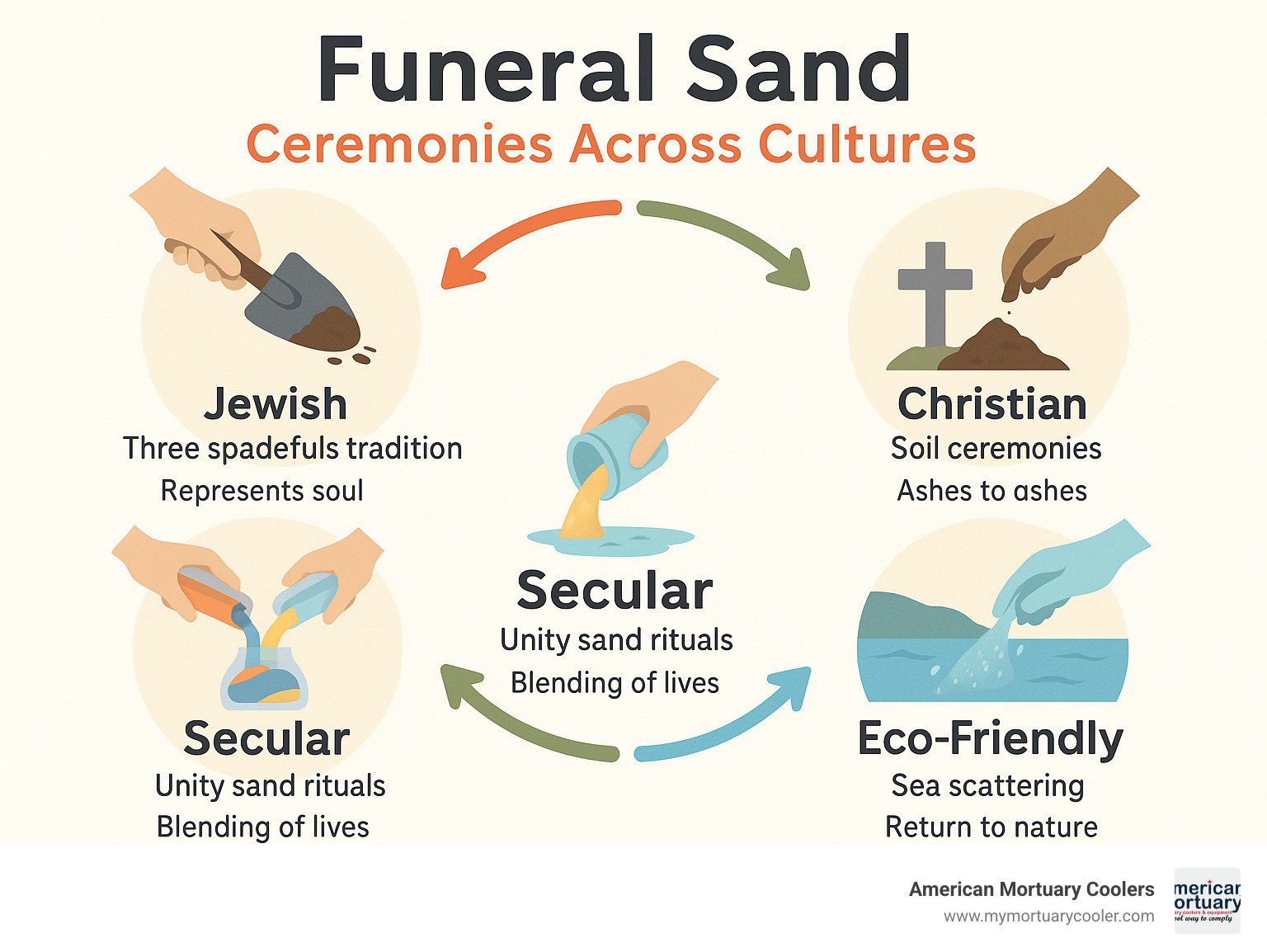
Essential funeral sand terms:
What Is Funeral Sand? Origins, Types & Meanings
When we talk about funeral sand, we're referring to more than just the soil that covers a casket. While that "foundation soil" is certainly part of it, the concept has evolved to include a rich variety of materials used in memorials, ceremonies, and keepsakes that honor our loved ones.
The practice of incorporating sand into funeral rituals isn't new – ancient Egyptians used sand in their elaborate burial ceremonies, and countless indigenous cultures worldwide have long included earth elements to symbolize our return to nature. There's something deeply comforting about this connection to the earth that transcends time and culture.
Today, funeral sand comes in several meaningful forms, each with its own purpose and symbolism:
Natural silica sand provides an uncolored, traditional option often used in conventional burials. Beach sand collected from places that held special meaning to the deceased creates a personal connection – I've seen families gather sand from favorite vacation spots or childhood beaches. Crushed quartz offers a finer, more uniform material that works beautifully in decorative applications, while biodegradable blends mixed with gelatin or similar materials dissolve naturally in water or soil. For unity ceremonies and keepsakes, colored craft sands create striking visual representations of blended lives and memories.
The symbolism varies with context. In traditional burials, funeral sand represents the "dust to dust" cycle of life. In unity ceremonies, different colored sands symbolize the merging of families and relationships. For ocean memorials, sand can represent the eternal, ever-changing nature of the sea.
Even the physical properties matter – coarser grains create dramatic visual layers in keepsake vessels, while finer sand pours more smoothly during ceremonies. Some families choose sand with tiny shells or minerals that add texture and personal meaning to their memorial.
Composition & Sourcing
The composition of funeral sand largely depends on how you plan to use it. Traditional burials typically use the natural soil from the cemetery itself. However, more specialized and ceremonial applications require carefully sourced materials.
Industrial-grade silica sand, like that provided by companies such as SIDCO Sands, undergoes processing to ensure consistent quality. This type of sand works perfectly for ceremonies where appearance and handling properties matter. According to industry standards, decorative silica sand typically features uniform grain size between 0.1 and 0.5 millimeters – just right for smooth pouring and clear visual layers.
When helping families source funeral sand for meaningful ceremonies, we consider several important factors:
Purity is essential – the sand should be free of organic material and contaminants. Consistent grain size ensures both smooth pouring during the ceremony and clear visual layers in keepsakes. For colored sands, color stability matters so that memorial items won't fade over time. And of course, we always check regional regulations, as some areas have specific rules about sand sourcing and disposal.
At American Mortuary Coolers, we've noticed funeral directors across our service areas – from our home base in Tennessee to California and everywhere in between – increasingly asking about appropriate sand options. Our supplier network ensures quality materials are available throughout the 48 contiguous states we serve.
For families wishing to incorporate sand from a meaningful location, we recommend collecting 2-3 cups per participant. This ensures everyone has enough for the ceremony. Just be sure to thoroughly dry and sift the sand to remove any debris before the service – those small preparations make a big difference in the final result.
Cultural & Religious Significance of Sand and Soil
There's something deeply meaningful about the way sand and soil connect us during our final goodbyes. Across nearly every culture and faith tradition in the world, we find people using earth elements in funeral rituals. This universal practice speaks to our shared human experience and our connection to the earth's natural cycles.
Funeral Sand in Jewish Burials
In Jewish tradition, the use of funeral sand carries profound significance. When mourners gather at a Jewish burial, they typically place three spadefuls of earth onto the coffin after it's lowered into the grave. These three spadefuls aren't just practical—they represent the three fundamental soul-levels in Jewish mysticism: nefesh (the animating life force), ruach (the emotional and moral self), and neshamah (the higher intellectual soul).
As one rabbi beautifully explains: "Indeed, in many communities it is customary for those in attendance to line up and everyone places three spadefuls of dirt over the coffin after it is placed in the ground."
Some Jewish communities have developed meaningful variations on this practice. Five spadefuls represent the addition of two higher "transcendent" soul-levels: chayah and yechidah. In other communities, thirteen spadefuls symbolize the thirteen words in Psalm 78:38, which mourners recite during the burial.
When there are many attendees or when shovels aren't practical, funeral directors often provide an urn of sand for mourners to take a symbolic handful. This physical participation in the burial process is considered a final kindness that cannot be repaid—a true act of selfless love.
For families looking to incorporate special vessels into these meaningful rituals, you can find more info about cremation urn choices on our resource page.
Catholic & Christian Practices
Anyone who has attended a Christian funeral has likely heard the familiar phrase "ashes to ashes, dust to dust" as soil is placed into the grave. This powerful reference comes from Genesis 3:19: "For dust you are and to dust you will return." In Christian traditions, especially Catholic funeral rites, this funeral sand ritual serves multiple meaningful purposes.
First, it symbolizes our return to the basic elements from which we were created. Second, it creates a sense of community and shared grief among mourners. And finally, it fulfills what Catholics consider a Corporal Work of Mercy—to bury the dead with dignity and care.
When asked if throwing soil into a grave is permitted during Catholic funeral rites, one Catholic source simply affirms: "In short, the answer is: Yes." The practice has deep roots in Jewish tradition but has become a standard element in Christian burials across many denominations.
There's a beautiful order to this ritual too. Typically, the spouse or closest family member begins, followed by other mourners based on their closeness to the person who has died. This orderly participation is considered "a great way of showing solidarity during mourning."
Some Christian scholars trace this practice back to ancient Egyptian funerary customs, where sand played an important role in burial preparations. This historical connection highlights how universal earth-based rituals are across time and different cultures.
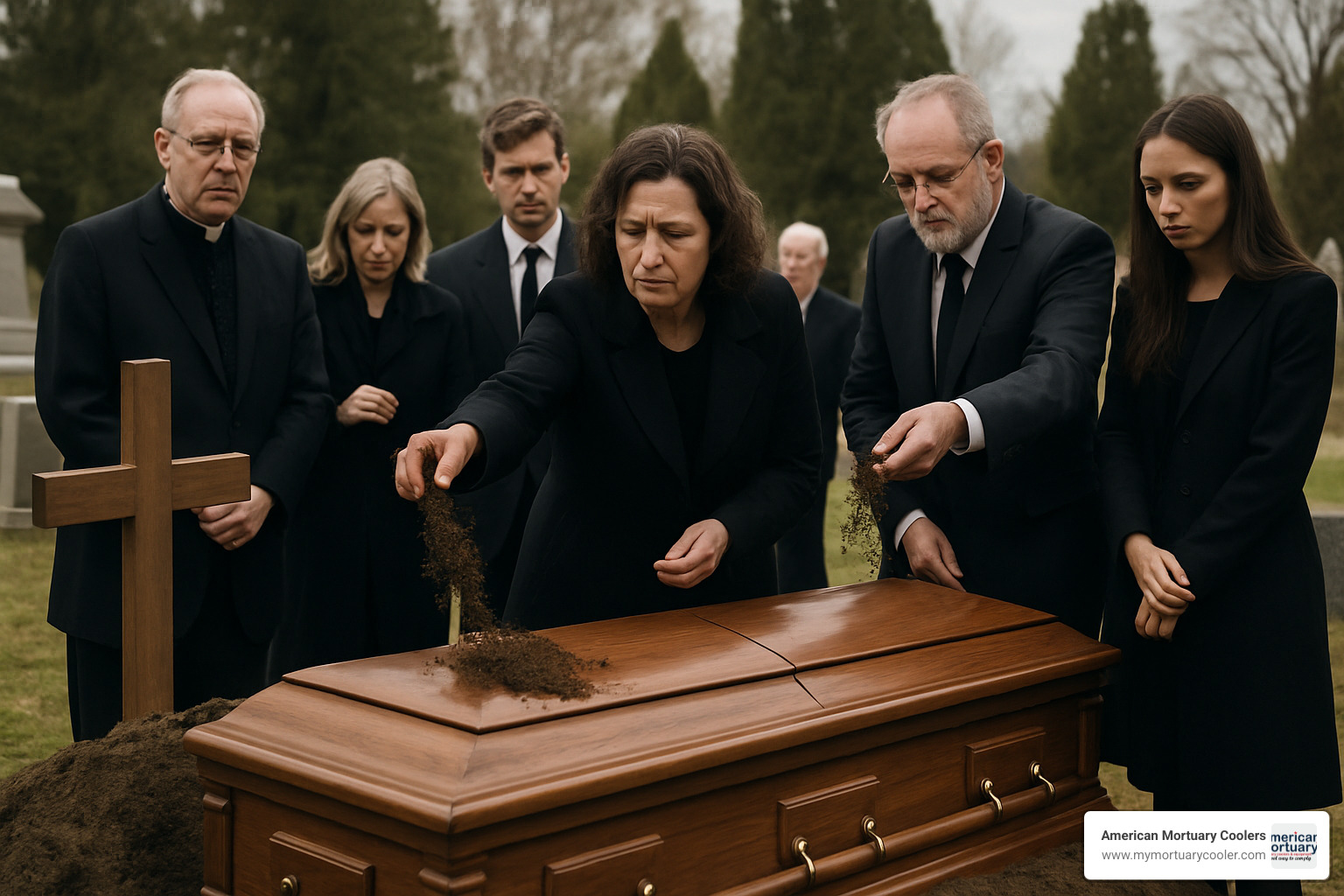
Secular & Multifaith Ceremonies
As our society grows more diverse and families seek more personalized ways to say goodbye, funeral sand has found beautiful new applications in secular and multifaith ceremonies. One of the most touching adaptations is the unity sand ritual, which was originally popularized in weddings (especially after being featured on "The Bachelorette").
In these heartfelt ceremonies, family members each pour different colored sands into a common vessel, creating distinct layers that represent their individual relationships with their loved one while forming a unified whole. The finished creation serves both as a meaningful ceremony and as a lasting keepsake.
For life-celebration events, these funeral sand ceremonies offer several comforts. They provide active participation for multiple family members, create a tangible memorial object, can incorporate personally meaningful colors or symbols, and easily accommodate diverse belief systems.
The colors families choose often carry special meanings: blue might represent tranquility, green a connection to nature, purple spirituality, or perhaps colors representing a favorite sports team or alma mater. Some families collect sand from places that were meaningful to their loved one—a favorite beach, a beloved hiking trail, or their childhood home.
For destination burials and ash scatterings, local sand often plays a special role. In Hawaii, for example, native sand has been used in ceremonial traditions for generations. This practice has naturally extended to memorial services where families sometimes combine cremated remains with local sand for scattering in a beautiful, meaningful way.
At American Mortuary Coolers, we're honored to support funeral directors across the country who help families incorporate these meaningful sand rituals into their services of remembrance. Whether traditional or contemporary, these simple yet profound gestures help us connect with our loved ones and with each other during our most difficult moments.
Modern Products & Personalization Options
As families seek more meaningful ways to honor their loved ones, the funeral industry has responded with innovative funeral sand products that blend tradition with personalization. These range from practical vessels to beautiful keepsakes that families can treasure for generations.
Today's funeral sand products offer something for every preference and budget. Biodegradable sand urns combine natural sand with eco-friendly binding agents, creating vessels that return gently to the earth or sea. Sand-infused caskets feature decorative sand panels or textured finishes that add warmth and natural elegance to traditional burial options.
For families wanting keepsakes, small vials of ceremonial sand allow each member to take home a physical reminder of the service. Unity vases, specially designed with clear walls to showcase layered colored sands, create stunning visual memorials that capture the unique relationships within a family. Some families choose custom-engraved display containers that include meaningful quotes or dates alongside the sand layers.
"The layers of sand represent the different roles our mother played in all our lives," shared one daughter after her mother's memorial. "We can look at this beautiful vessel and remember how she brought us all together."
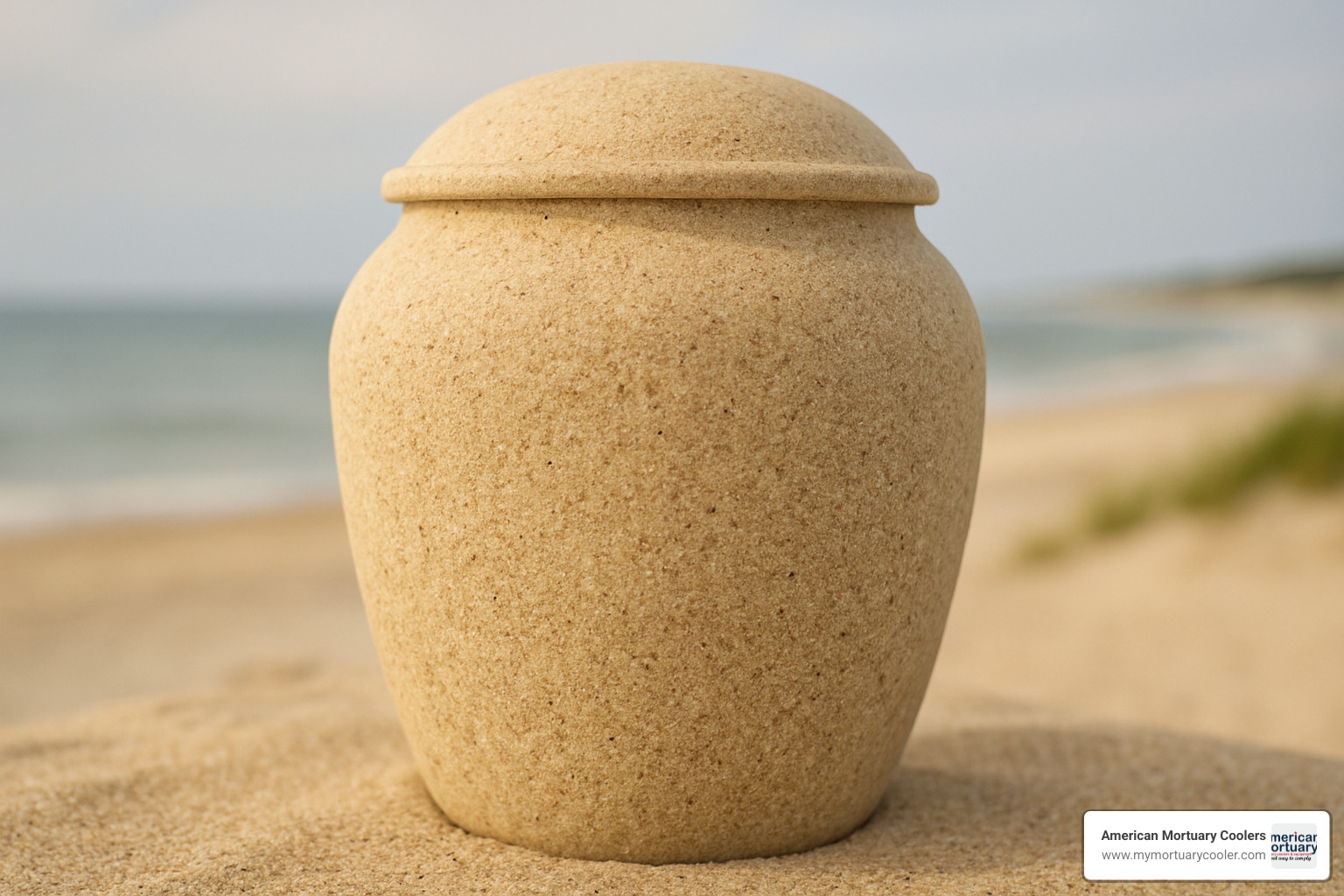
The Ocean Sand Urn has become one of our most requested options. Available in small (50 cubic inches) and large (200 cubic inches) sizes, these beautiful urns combine natural beach sand or crushed quartz with sustainable gelatin. The result is a vessel that honors both the loved one and the environment, dissolving naturally in water or biodegrading in soil.
Casket manufacturers have acceptd sand themes as well. Models like the "Sand Casket" and "Golden Sand Casket" feature warm tan finishes with gold hardware, creating a sense of natural elegance. The Sand casket includes thoughtful details like a rosetan crepe lining and the Charpente® Interior System, weighing 190 pounds with interior dimensions of 22.13" H x 79.88" L x 24.88" W.
Funeral sand ceremonies offer nearly limitless creative possibilities for personalization. Children often participate with their own colored sand, making these ceremonies ideal for blended families or honoring multiple generations. Some families incorporate sand from meaningful locations—a favorite beach, hiking trail, or childhood home—adding another layer of personal significance.
Memorial jewelry containing small amounts of funeral sand has also gained popularity. Pendants, bracelets, and even rings can hold a tiny portion of ceremonial sand, allowing family members to keep their loved one close in a subtle, meaningful way.
At American Mortuary Coolers, we've noticed growing interest in these personalized options across our entire service area. Our nationwide distribution network ensures that funeral directors throughout the contiguous 48 states can access quality supplies to support these meaningful ceremonies, regardless of their location.
Eco-Friendly Burials & Environmental Impact
The growing desire for environmentally conscious funeral options has brought funeral sand to the forefront of the green burial movement. Biodegradable sand urns and sea scattering ceremonies offer families beautiful ways to honor their loved ones while respecting our planet.
Biodegradable sand urns blend naturally with the environment, typically decomposing in soil within about three months or breaking down in water in just three days. These urns leave no lasting environmental footprint—just memories. Many designs include small holes that allow water to enter, giving the urn a brief, dignified float before it gently sinks during sea ceremonies.
"My father loved the ocean more than anything," one son told us after his father's sea burial. "Watching his sand urn slowly sink into the waters where he'd spent his happiest days felt exactly right."
Sea scattering services have become particularly popular in coastal regions. San Diego Burial at Sea notes that approximately 60% of Californians now choose cremation, with many selecting ash scattering as their final wish. These services typically use stable vessels in protected waters—90% of San Diego's ceremonies take place within the sheltered bay—ensuring a comfortable, dignified experience for families.
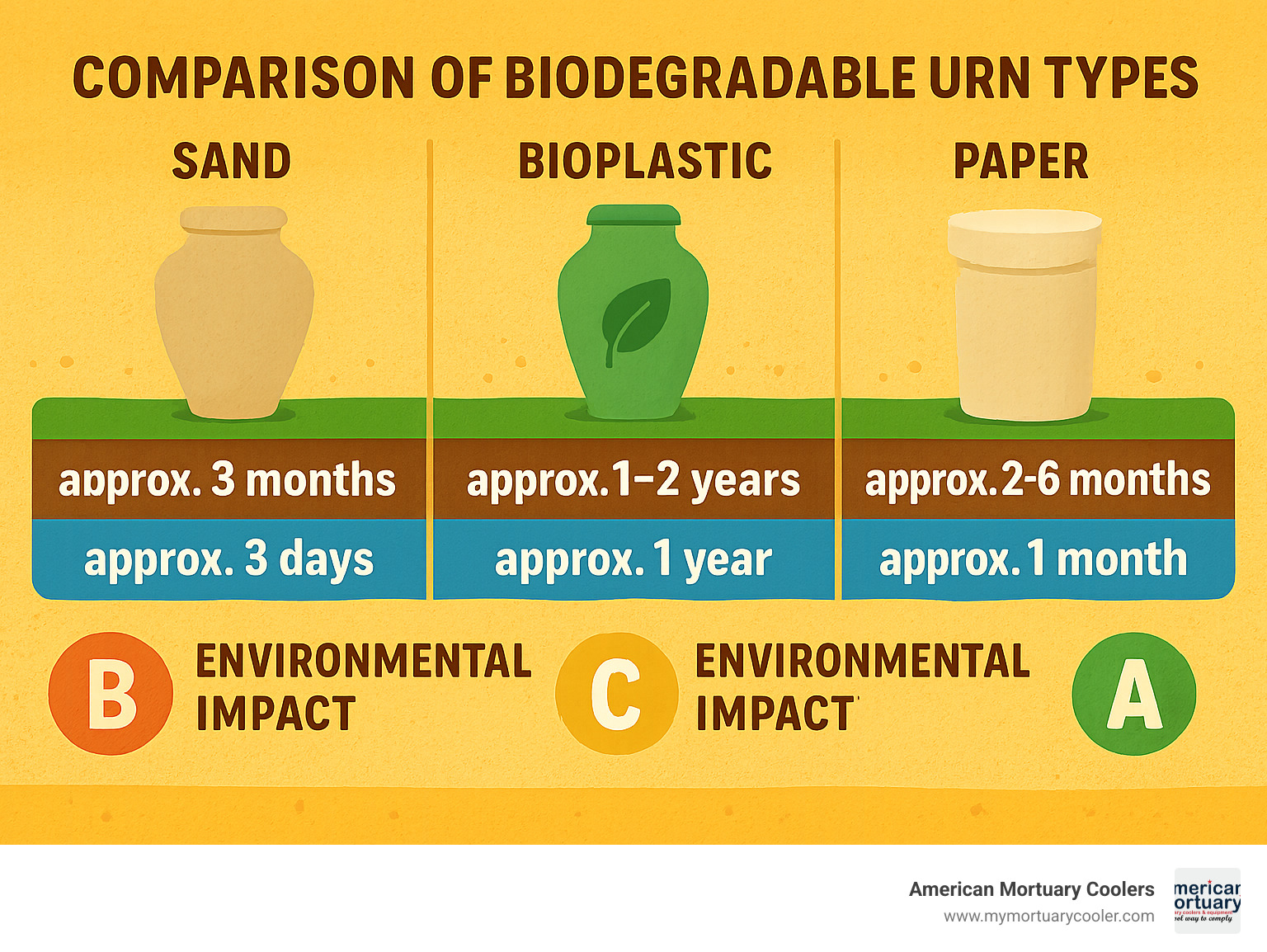
When planning a sea ceremony, families should be aware of environmental regulations—California requires scattering to occur at least 500 yards from shore—and should use only biodegradable materials, including flowers free of wire or plastic. Many services provide GPS recording of the exact scattering location, creating a meaningful place families can revisit, even if only in spirit.
For land-based green burials, funeral sand integrates beautifully with natural cemetery practices. Some green burial grounds encourage families to use local soil or sand during the interment, creating a direct connection to the specific ecosystem where their loved one will rest.
Funeral Sand Ceremony Scripts & Supplies
Creating a meaningful funeral sand ceremony requires thoughtful preparation of both the practical elements and the words that will accompany this powerful ritual. We've helped countless funeral directors and families create ceremonies that truly honor their loved ones.
The central element of any sand ceremony is the main vessel—typically 8-10 inches tall and clear-sided to showcase the beautiful sand layers. Each participant needs their own pouring vessel, usually 4-6 inches tall, filled with their chosen sand color. A funnel helps create distinct layers, while a stable display stand ensures the final vessel remains a focal point during and after the ceremony.
Many families choose to personalize their vessels with engraving, photographs, or decorative elements that reflect their loved one's personality or interests. One family incorporated seashells collected during annual beach vacations; another used sand from the baseball field where their father had coached for thirty years.
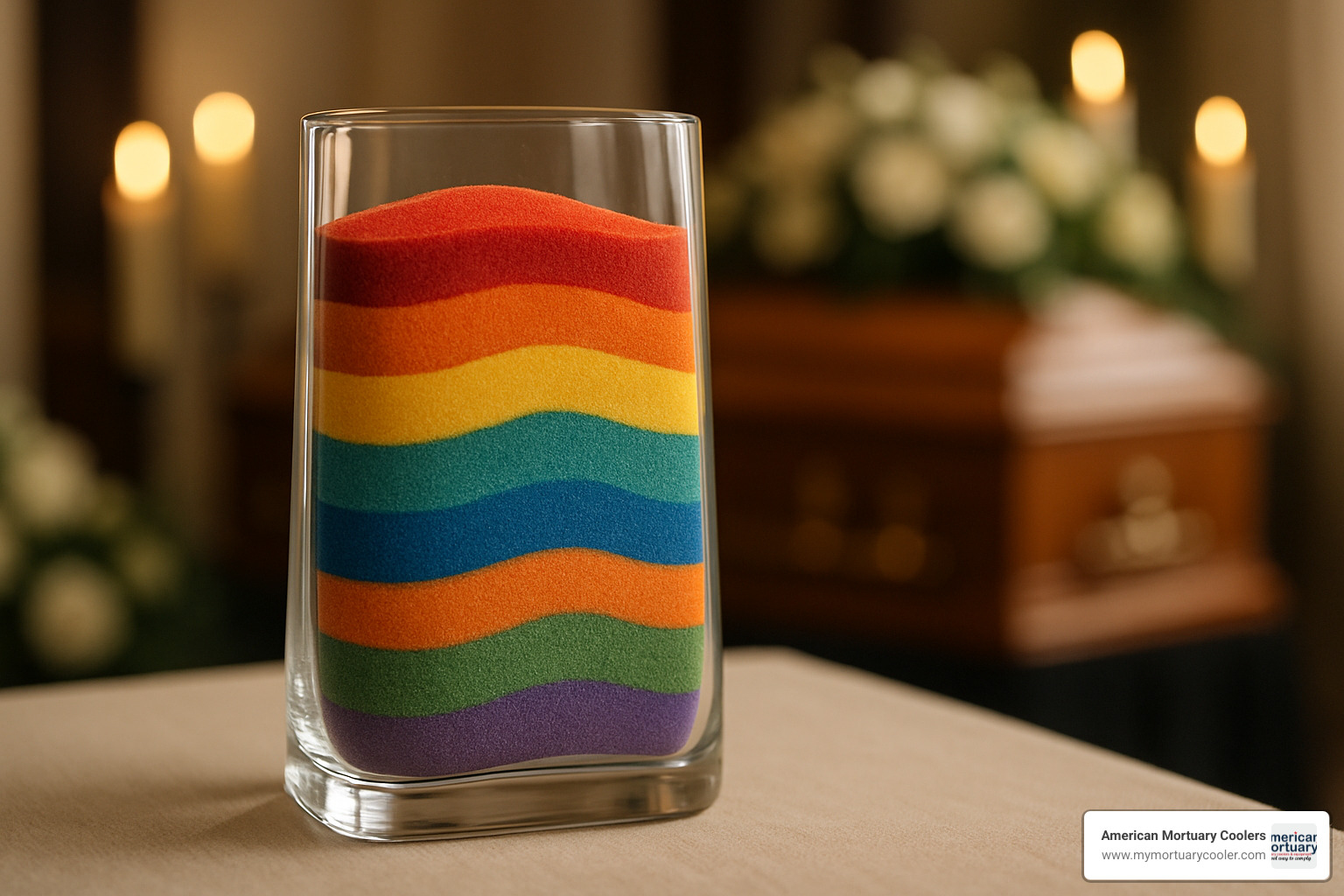
The words spoken during a funeral sand ceremony should reflect the unique personality and beliefs of the person being honored. Popular readings often emphasize the permanent blending of the sands: "Just as these grains of sand can never be separated, so will our memories of Michael remain forever part of us." Others highlight the symbolism of different colors: "Each color represents a quality we cherished in Sarah: blue for her tranquility, red for her passion, yellow for the light she brought to our lives."
When children participate, simple language helps them understand their important role: "The blue sand is from Emma, who loved building sandcastles with Grandpa at the beach." This involvement helps children process grief in a tangible, age-appropriate way.
For families interested in incorporating fully biodegradable elements into their ceremonies, we've compiled additional resources in our guide Ashes to Earth: The Complete Guide to Biodegradable Urns.
At American Mortuary Coolers, we understand that these details matter deeply during times of loss. While our primary focus is providing quality mortuary equipment, we're committed to supporting funeral professionals with the knowledge and resources they need to offer meaningful ceremonies that truly comfort families.
Practical Guide for Families & Funeral Directors
Planning a meaningful funeral sand ceremony doesn't need to be complicated, but attention to practical details makes all the difference. Whether you're a funeral director guiding a family through options or a family member planning a service, these considerations will help create a beautiful, trouble-free experience.
When sourcing clean sand, you have several options. Traditional burials typically use cemetery soil, which is readily available at the gravesite. For decorative ceremonies, I recommend purchasing craft sand from established suppliers to ensure it's free from contaminants and consistent in appearance. If families wish to collect beach sand from a meaningful location, remind them to thoroughly dry and sift it before the ceremony – this prevents clumping and ensures smooth pouring.
Figuring out how much sand you'll need is straightforward. For individual pouring vessels, plan for about ½ to 1 cup per participant. Your main vessel should accommodate the combined volume plus about 20% empty space at the top to prevent overflow. For graveside ceremonies where many people will participate, 3-5 pounds of sand is typically sufficient for every 10 attendees.
Funeral directors, here are some handling tips I've learned from working with funeral homes across the country:
Pre-fill the pouring vessels before the service begins to save time and reduce anxiety. Using funnels for the main vessel prevents messy spillage that can detract from the solemnity of the moment. Always have extra sand on hand – accidents happen, especially when emotions run high. For outdoor ceremonies, be mindful of weather conditions – even a gentle breeze can disrupt sand pouring. Whenever possible, practice the pouring sequence with key family members beforehand so they feel comfortable with their role.
For distributing sand at graveside services, small shovels are traditional, but many funeral homes now offer specialized distribution cones or individual sand packets for larger gatherings. These thoughtful touches allow more mourners to participate without creating long delays.
Health and safety shouldn't be overlooked. Consider providing masks if you're using very fine sand that might become airborne. Ensure stable footing around gravesites, especially important for elderly participants. Make accommodations for mobility-impaired guests so everyone can participate. Having hand-cleaning options available after handling sand is a small courtesy that families appreciate.
If families need to travel to services, let them know that TSA generally permits transportation of sand in carry-on luggage, though sealed containers are strongly recommended to prevent spills. Memorial urns containing cremated remains have specific TSA requirements and should be properly documented – a detail worth mentioning to traveling family members.
As for pricing, funeral sand elements vary widely based on customization:
- Basic colored craft sand typically runs $5-15 per pound
- Personalized unity sand sets range from $50-150
- Custom engraved vessels cost between $75-300
- Professional sand ceremony coordination may add a $100-500 service fee
At American Mortuary Coolers, we've built relationships with quality suppliers throughout our service regions. This network allows us to guide funeral homes on sourcing the best materials at reasonable costs. With our direct delivery across all 48 contiguous states, even funeral homes in remote locations can access specialized supplies for these meaningful ceremonies.
Legal Considerations & Best Practices
Navigating the legal aspects of funeral sand ceremonies is an important part of planning. As a funeral director, you're the guide helping families create meaningful tributes while staying within regulatory boundaries.
For traditional burials, cemetery bylaws often specify who may place soil on the casket and when this occurs during the service. Some cemeteries limit this practice to immediate family members or require staff supervision. I always recommend checking with the specific cemetery before finalizing these details – a quick call can prevent disappointment on the day of service.
When funeral sand is part of ash scattering ceremonies, environmental regulations come into play. California funeral law, for instance, requires that ash scattering at sea must occur at least 500 yards from shore. The Environmental Protection Agency maintains similar requirements nationwide. These aren't arbitrary rules – they're designed to protect marine environments while still honoring the wishes of the deceased.
Public places like beaches and parks often require permits for organized scattering ceremonies. While requirements vary by location, you'll typically need to submit an application 30-90 days in advance, pay fees ranging from $50-250, and adhere to restrictions on group size and designated ceremony areas. Planning ahead prevents last-minute complications that can add stress to an already emotional time.
Based on our experience serving funeral homes from Johnson City, Tennessee to Los Angeles, California, I've observed that successful funeral directors follow these best practices when incorporating funeral sand:
Document everything carefully, including sand sources and any permits obtained. Be transparent with families about any regulatory restrictions – they appreciate honesty upfront rather than surprises later. Always have backup plans for weather or unexpected circumstances. Ensure all participants understand the significance of the ritual, which adds to its meaning. Make thoughtful accommodations for elderly or disabled participants so everyone feels included.
When cremated remains are mixed with sand and will cross state lines or international borders, additional documentation may be required. Always verify current requirements with relevant authorities before planning interstate transport – requirements change periodically, and staying informed protects both you and the families you serve.
Creative Ways to Include Funeral Sand
Beyond traditional ceremonies, funeral sand offers wonderful opportunities for personalized memorials that truly celebrate a life. These creative approaches help families process grief while creating lasting tributes.
The Beach Collection Memorial has become increasingly popular, especially for those who shared special moments at the shore. Families visit a beach significant to their loved one, collect sand together, and use it in a unity ceremony. One family I worked with in California gathered at their grandfather's favorite fishing spot, collecting sand at sunrise before his service. The shared experience became part of their healing journey, and the resulting sand vessel now sits prominently in their family home.
Engraved Shadow Boxes offer another beautiful option. These custom boxes with engraved glass display layered colored sands alongside photographs and small mementos. Wall-mounted and illuminated, they become conversation pieces that celebrate the deceased's life rather than focusing solely on their passing. One widow created a shadow box using sand from her husband's favorite golf course, layered with the colors of his alma mater.
The Mixed Flower Petal and Sand Ceremony creates striking visual patterns by alternating layers of dried flower petals with colored funeral sand. Each participant adds both elements, representing both the beauty and foundation of their relationship with the deceased. This approach works beautifully for memorial gardens or biodegradable urns.
Some families practice an Anniversary Sand Return, saving portions of memorial sand to return to significant locations on anniversary dates. This creates an ongoing ritual of remembrance that evolves over time and helps family members process grief gradually rather than all at once.
Intergenerational Sand Art involves children and grandchildren creating sand art designs in smaller containers using colors representing the deceased. This allows even young family members to participate meaningfully while creating keepsakes they can treasure as they grow.
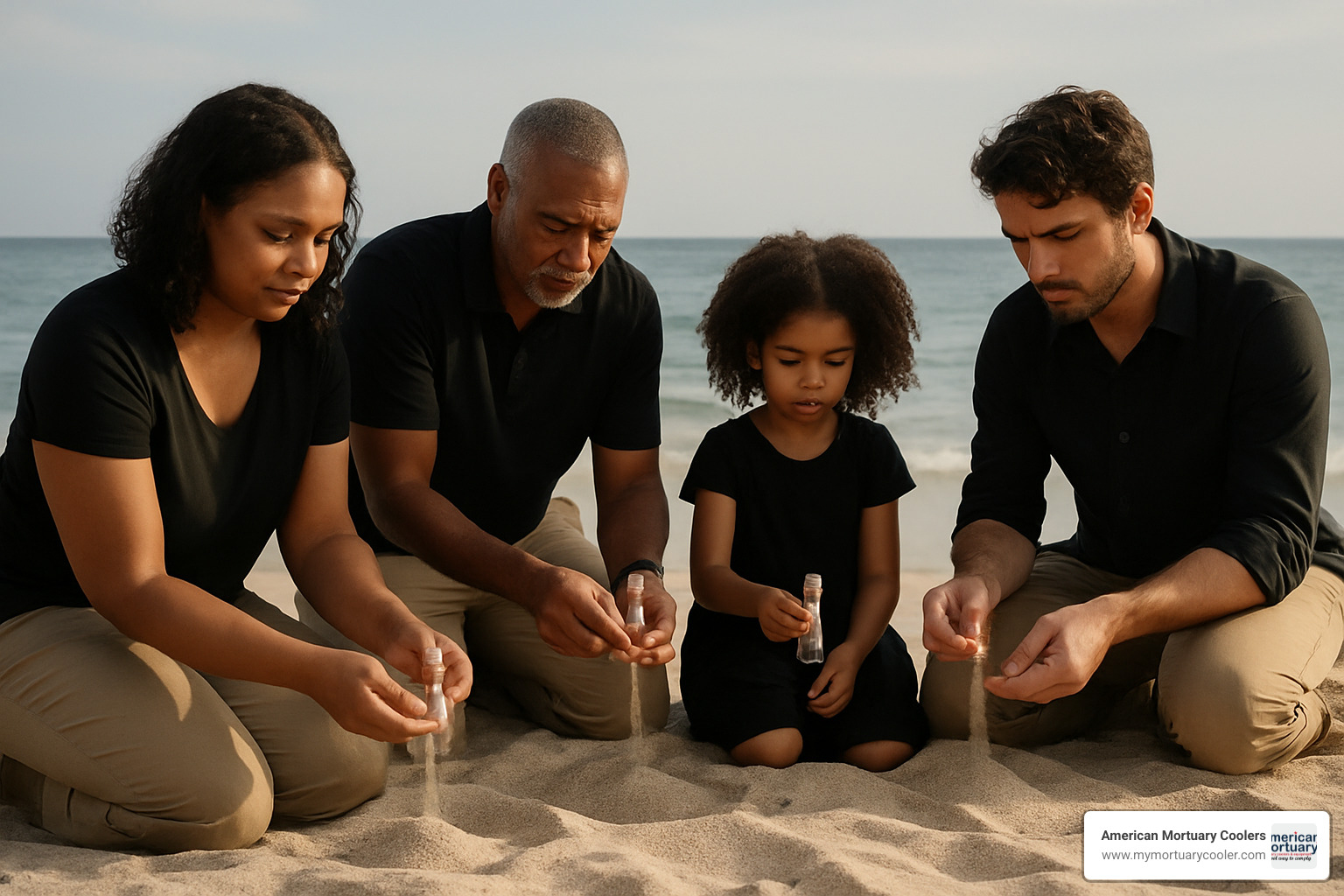
For destination memorials, local sand carries special significance. Hawaiian memorial services often incorporate the islands' distinctive colored sands – black volcanic, pristine white, and even rare green sand – creating striking visual memorials that connect to the location's natural beauty.
I've seen families create "living memorials" by using funeral sand in potted plants or garden features. The sand serves as drainage material while symbolically supporting new life, creating an ongoing connection to their loved one through something that continues to grow and thrive.
At American Mortuary Coolers, we've partnered with funeral directors throughout our nationwide service area to develop custom solutions for these creative approaches. Our experience across diverse communities has shown that personalizing funeral sand elements significantly improves the memorial experience for families, giving them tangible ways to honor their loved ones that extend beyond the funeral service itself.
Frequently Asked Questions about Funeral Sand
Is there a specific amount of sand to use in each tradition?
When it comes to funeral sand, the amount used varies widely depending on cultural traditions and the purpose of the ceremony.
In Jewish burials, there's beautiful symbolism in the numbers. Each mourner traditionally places three spadefuls of earth on the coffin, representing the three soul-levels: nefesh (the animating life force), ruach (the emotional self), and neshamah (the higher intellectual soul). Some communities deepen this symbolism by using five spadefuls to include two additional transcendent soul-levels, or thirteen spadefuls to honor the thirteen words in Psalm 78:38.
Christian traditions take a more flexible approach. There's no prescribed amount of soil or sand—the power lies in the symbolic act itself rather than the quantity. Most mourners place a single handful or small shovelful, often while the words "ashes to ashes, dust to dust" are spoken.
For families choosing unity sand ceremonies, practicality meets symbolism. Each participant typically pours between half to one cup of colored sand, creating distinct layers in the main vessel. Be sure to choose a container with about 20% extra space at the top to accommodate all contributions while maintaining a polished appearance.
At graveside services, we've found that preparing approximately 3-5 pounds of sand or soil for every 10 attendees ensures everyone can participate meaningfully without running short. It's always better to have a little extra than not enough in these emotional moments.
Can we mix beach sand with cremated remains?
Yes, mixing beach sand with cremated remains has become increasingly popular, especially for families seeking connection to meaningful places. This practice creates beautiful opportunities for personalized memorials, though there are several important considerations to keep in mind.
First, legal compliance is essential. Always check local regulations before collecting sand or scattering remains, as some beaches prohibit these activities. California's funeral law, for instance, requires that ash scattering at sea must occur at least 500 yards from shore.
When mixing materials, proportions matter. Cremated remains have a distinctive texture and color that differs from most sand. For visual harmony, we typically recommend roughly 1 part remains to 3-4 parts sand. This balance creates a meaningful blend while maintaining a natural appearance.
Always obtain collection permission before gathering sand from any beach or public space. Many locations have restrictions on removing natural materials, and respecting these guidelines honors both the location and your loved one's memory.
For families planning sea scatterings, environmental impact deserves careful thought. Ensure that any additional materials mixed with remains—flowers, notes, or decorative elements—are fully biodegradable. This consideration has become increasingly important as approximately 60% of Californians now choose cremation, with many selecting ocean scattering as their final wish.
If you're creating keepsakes with this mixture, we recommend sealed glass containers rather than porous materials. This simple choice prevents leakage and preserves your memorial beautifully for years to come.
What colors work best for a unity sand memorial?
Choosing colors for a unity sand memorial is both an artistic and deeply personal decision. The most meaningful selections balance visual impact with the unique story of your loved one's life.
We've found that the most visually striking combinations include contrasting colors that create distinct layers. Think of the dramatic effect of dark blue against white, or amber against teal. These combinations ensure each contribution remains visually distinct in the final memorial.
Many families also consider complementary colors that naturally harmonize. Classic pairings like blue and orange or purple and yellow create a sense of visual completeness that can feel deeply satisfying during a time of loss.
Above all, choose meaningful colors that represented the deceased's preferences or life journey. Did they have a favorite color? Were they passionate about a sports team or alma mater? Did certain colors represent their hobbies or cultural heritage? These personal connections transform a beautiful object into a deeply meaningful tribute.
From our experience working with families across the country, we recommend limiting your palette to 3-5 colors. This restraint prevents a "muddy" appearance when colors are layered while still allowing for meaningful variety. Many families use white or natural sand as an effective base or separator between more vibrant colors.
Popular color choices carry their own symbolic associations: blue suggests tranquility and heavenly connections; green represents nature and renewal; purple conveys dignity and wisdom; while yellow brings sunshine and optimism into the memorial. Red speaks of love and passion, white symbolizes peace and spiritual transition, and natural sand grounds the memorial in authenticity and earth connection.
For the finished display, consider where the memorial will be kept. Colors appear differently under various lighting conditions—some vibrant hues shine in natural light, while others maintain their appearance better indoors. This small consideration ensures your memorial remains beautiful for years to come.
Conclusion
As we've journeyed through the traditions, applications, and symbolism of funeral sand, I hope you've finded how this simple element carries profound meaning across different cultures and contexts. From those three spadefuls in Jewish traditions to colorful unity sand ceremonies, these grains connect us to something timeless and deeply human.
Here at American Mortuary Coolers, we believe every aspect of a funeral service matters—whether it's the essential equipment we provide or the meaningful ceremonial elements that bring comfort to families. Our custom mortuary coolers serve funeral homes throughout the lower 48 states, supporting professionals like you who guide families through their most difficult moments.
Incorporating funeral sand into a memorial service isn't just about following tradition—it's about creating moments of active participation and tangible meaning. There's something powerfully grounding about the weight of sand in your palm, the soft sound as it falls onto a casket, or the beautiful layers of color in a memorial vessel. These sensory experiences can help mourners process grief in ways that words alone sometimes cannot.
For funeral directors looking to expand their service offerings, our team is always available to provide guidance on equipment and resources that support meaningful funeral sand ceremonies. We understand that the funeral profession is both an art and a service, requiring both practical solutions and a compassionate touch.
Whether you're considering eco-friendly options like biodegradable sand urns, planning a traditional burial with graveside sand rituals, or creating a personalized unity sand ceremony, these practices honor both ancient traditions and individual preferences. What matters most is creating experiences that help families begin their healing journey.
From our headquarters in Tennessee to funeral homes across the country, we're committed to supporting your important work with quality equipment and thoughtful resources. After all, what you do matters—you help families honor lives and create lasting memories during their most vulnerable moments.
For more information on how we support the funeral industry with quality equipment and resources, visit More info on mortuary solutions.